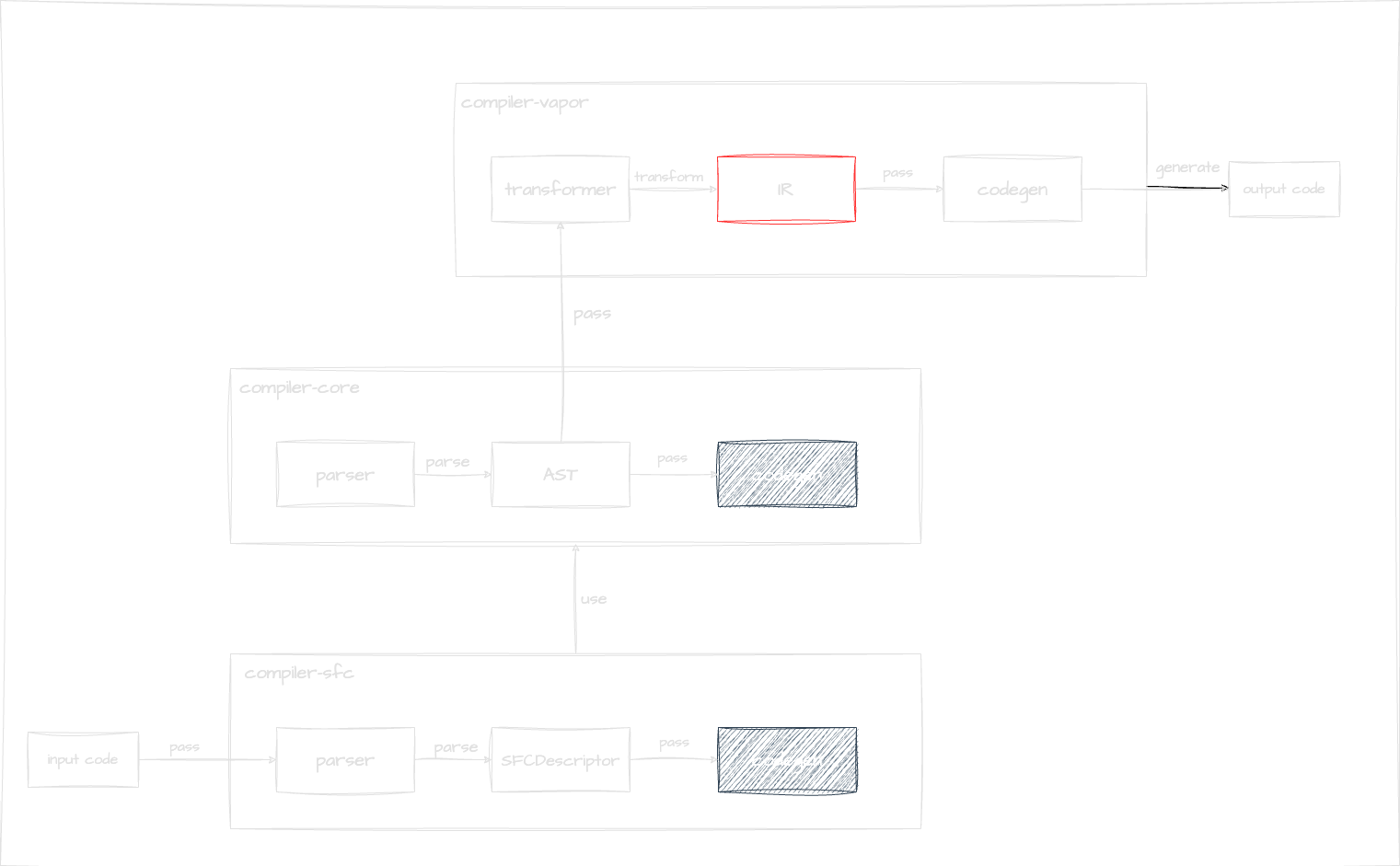The IR in Vapor Mode
Now, let's move on to the IR.
From here, we'll delve into the specific implementations of Vapor Mode.

We'll first look at the IR before proceeding to read the source code of the transformer.
What is IR?
IR stands for Intermediate Representation.
While the SFCDescriptor and AST were essentially structured versions of the user's (web application developer's) input code, the IR can be thought of as the "structured version of the output code."
The definition of IR can be found in ir/index.ts.
packages/compiler-vapor/src/ir/index.ts
Recall the compiler output of the small component we read at the beginning:
import { template as _template } from "vue/vapor";
const t0 = _template("<p>Hello, Vapor!</p>");
function _sfc_render(_ctx) {
const n0 = t0();
return n0;
}It's somewhat difficult to output these directly from the AST.
As a strategy, we can prepare an object (IR) to represent the code above, generate the IR by manipulating the AST, and then pass that IR to the codegen, thereby designing the compiler programmatically.
Let's actually see what kind of IR the component above will produce.
We can check this by inserting logs into our local compiler.
There's a transform function around the following area, so let's output the ir after the transform.
76 const ir = transform(
77 ast,
78 extend({}, resolvedOptions, {
79 nodeTransforms: [
80 ...nodeTransforms,
81 ...(options.nodeTransforms || []), // user transforms
82 ],
83 directiveTransforms: extend(
84 {},
85 directiveTransforms,
86 options.directiveTransforms || {}, // user transforms
87 ),
88 }),
89 ){
"type": 0,
"node": {
"type": 0,
"source": "\n <p>Hello, Vapor!</p>\n",
"children": [
{
"type": 1,
"tag": "p",
"ns": 0,
"tagType": 0,
"props": [],
"children": [
{
"type": 2,
"content": "Hello, Vapor!"
}
]
}
],
"helpers": {},
"components": [],
"directives": [],
"hoists": [],
"imports": [],
"cached": [],
"temps": 0
},
"source": "\n <p>Hello, Vapor!</p>\n",
"template": ["<p>Hello, Vapor!</p>"],
"component": {},
"directive": {},
"block": {
"type": 1,
"node": {
"type": 0,
"source": "\n <p>Hello, Vapor!</p>\n",
"children": [
{
"type": 1,
"tag": "p",
"ns": 0,
"tagType": 0,
"props": [],
"children": [
{
"type": 2,
"content": "Hello, Vapor!"
}
]
}
],
"helpers": {},
"components": [],
"directives": [],
"hoists": [],
"imports": [],
"cached": [],
"temps": 0
},
"dynamic": {
"flags": 1,
"children": [
{
"flags": 1,
"children": [
{
"flags": 1,
"children": []
}
],
"id": 0,
"template": 0
}
]
},
"effect": [],
"operation": [],
"returns": [0]
}
}This is the actual IR.
Due to the types in the IR being represented as enums, they appear as numbers, making it a bit hard to understand. Let's replace them with the specific IR Node names and remove unnecessary parts.
Then it becomes something like the following:
{
"type": "RootIRNode",
"node": {
"type": "RootNode",
"source": "\n <p>Hello, Vapor!</p>\n",
"children": [
{
"type": "ElementNode",
"tag": "p",
"ns": 0,
"tagType": 0,
"children": [
{
"type": "TextNode",
"content": "Hello, Vapor!"
}
]
}
],
"temps": 0
},
"source": "\n <p>Hello, Vapor!</p>\n",
"template": ["<p>Hello, Vapor!</p>"],
"block": {
"type": "BlockIRNode",
"node": {
"type": "ElementNode",
"source": "\n <p>Hello, Vapor!</p>\n",
"children": [
{
"type": "ElementNode",
"tag": "p",
"ns": 0,
"tagType": "Element",
"children": [
{
"type": "TextNode",
"content": "Hello, Vapor!"
}
]
}
],
"temps": 0
},
"returns": [0]
}
}First, there's a RootIRNode at the root. This is the root of the IR.
This RootIRNode contains information such as node, template, and block.
The node is the RootNode of the AST.
56export interface RootIRNode {
57 type: IRNodeTypes.ROOT
58 node: RootNode
59 source: string
60 template: string[]
61 component: Set<string>
62 directive: Set<string>
63 block: BlockIRNode
64}Then, the block contains a BlockIRNode, which represents a Block, the unit of elements handled in Vapor.
63 block: BlockIRNode47export interface BlockIRNode extends BaseIRNode {
48 type: IRNodeTypes.BLOCK
49 node: RootNode | TemplateChildNode
50 dynamic: IRDynamicInfo
51 effect: IREffect[]
52 operation: OperationNode[]
53 returns: number[]
54}Here, let's explain a bit about Block.
What is a Block?
A Block is the unit handled in Vapor Mode.
It's similar to a VNode (virtual DOM node) in non-Vapor Mode.
The definition of Block is in runtime-vapor, so let's take a look.
26export type Block = Node | Fragment | ComponentInternalInstance | Block[]
27export type Fragment = {
28 nodes: Block
29 anchor?: Node
30 [fragmentKey]: true
31}Looking at this, you can get an idea of what a Block is.
A Block takes a Node (DOM Node), a Fragment, a Component, or an array of Blocks.
Basically, Vapor constructs the UI using this unit called Block.
For example,
const t0 = template("<p>Hello, Vapor!</p>");
const n0 = t0();Here, n0 becomes a Block, which is a Node (Element).
We'll look at this in more detail when we explain the runtime, but let's briefly look at the template function.
2export function template(html: string) {
3 let node: ChildNode
4 const create = () => {
5 // eslint-disable-next-line no-restricted-globals
6 const t = document.createElement('template')
7 t.innerHTML = html
8 return t.content.firstChild!
9 }
10 return (): Node => (node || (node = create())).cloneNode(true)
11}It simply inserts the template into innerHTML and returns its firstChild.
In other words, this is just an ElementNode.
Sometimes it's an Element, sometimes a Component, or sometimes composed of arrays of those. The Block is the smallest unit used to construct the UI.
In the future, operations such as registering event listeners or updating text will be performed on this Block.
We'll read the definitions of each IR as they appear while we read various components from here on, so we'll end the explanation of IR here.
For now, it's sufficient to understand the general idea of what IR is and how the small component we're reading at the beginning is represented in IR.
